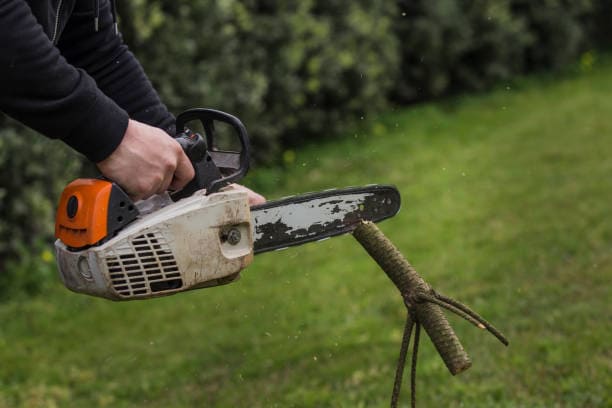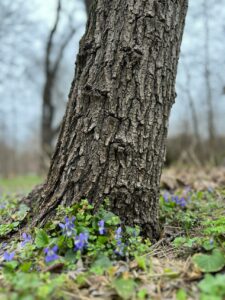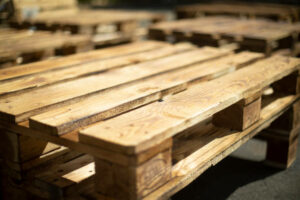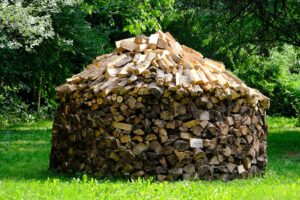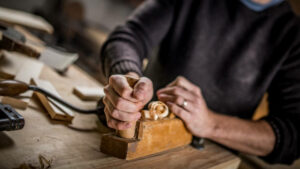There are a variety of lumber equipment and tools used in the lumber industry. Powerful feller bunchers, part of heavy logging equipment, have sharp blades that cut through tree trunks. Skidders, which are specialized vehicles with large wheels or tracks, transport logs and other heavy materials in forests.
Once the logs reach a mill, they are processed. Woodworking machines break them down into cants and flitches, and darker strips of their bark.
Sawmill Equipment
Sawmills function as massive, highly efficient facilities for processing raw logs into finished lumber products. Modern technology plays a significant role in bringing efficiency and automation into the milling process. Sensors, lasers, and color vision technologies are used to identify wood grades and optimize cutting strategies. They help reduce labor and increase production, allowing the company to create more diverse timber products.
Before entering the mill, the logs are scaled for measurement and inspection. They are also identified by the location and species of tree for tracking purposes. Once inside, they are sorted by parameters that include intended end use and moisture content. A giant circular buck saw then cuts the logs into boards and flitches. These are then inspected, bundled, and moved to wholesale lumber distributors.
Depending on the product, some of the lumber is kiln-dried before being used. This reduces moisture and makes it easier to work with the wood. A kiln can also raise the value of the lumber, particularly for high-quality woods like hardwood and timber. Other lumber is processed into plank floors, sheathing structures, and frames for furniture. The company can even produce specialized boards that feature interlocking tongue-and-groove shapes, shiplap edges, and rounded profiles.
Wood Processing Machinery
Woodworking machinery is a key piece of equipment that improves the process of shaping material. It increases the quality and precision of the work, enables mass production, and ultimately raises overall productivity.
Wood processing plants have many specialized areas that include debarking, drying, pulping, gluing and pressing, planing, milling, and sawing. All of these processes are tightly interconnected and require a high level of automation and maintenance.
A planer is a machine that smoothes and evens wood surfaces and can be used to prepare boards for other machines. Router machinery can cut different designs and patterns into the wood using a variety of bits. Grinding machines are also a vital tool for woodworking, as they can be used to smooth out rough parts of the finished product.
As wood processing requires the use of various power tools, it also produces byproducts that must be properly handled and stored. The proper disposal of wood waste is a crucial step in maximizing the value of raw materials and optimizing production efficiency. KEB’s system solutions help manage this important task by ensuring that the conveyors are positioned precisely and safely with dynamic drives for the best possible results. This ensures that the machines can work at optimum speeds while maintaining a precise position – even in complex applications such as rotary cones or a revolving drill with integrated sensors.
Skidders
Skidders are a crucial part of the logging process, transporting logs from the forest to the sawmill. They come in a variety of sizes, configurations, and types, each with its own set of advantages, functions, and limitations.
Originally, skidders were pulled by a team of oxen or a pack of mules. The oxen or mules straddled the cart over fallen logs, and the dangling tongs clamped them to drag them along between the rolling wheels.
Modern wheeled and tracked skidders have hydraulic grapple buckets that grab, hold, and drag logs over the ground to their destination. These machines work well in clear and partial cuts, and they can haul larger logs than forwarders can. They also work well in wet soil conditions that other forestry machinery cannot easily maneuver in.
When using a skidder, you should make sure that your machine is properly equipped for the terrain and load it with an appropriate number of logs. You should also perform a walk-around inspection before operating the equipment and ensure that it is serviced according to manufacturer specifications. In addition, you should use caution when working near the front of a skidder, as its blade and grapple arm may impede your line of sight.
Harvester Processors
Harvester processors work as companions to feller bunchers and help loggers get the most out of their harvested trees. These machines grab already-cut tree stems and process them into merchantable lengths. They are a valuable tool for both selection (polycyclic) harvesting systems and clear cuts where slope allows.
A processor is a wheeled or tracked machine with a specialized metal processing head that can fall and cut the stem of a tree to the desired length. It can also double and buck a tree, depending on the model. Some can rehandle harvested trees for transporting, working as part of a helicopter or cable system.
While a harvester can handle thinnings with relatively flat terrain, it is better suited to large clearcutting projects where the terrain is more steep. It is often used in conjunction with ground crews using chainsaws to remove individual trees on very steep hills.
A truck-mounted loader consists of a three-axle truck that has a loader crane mounted on top, allowing the machine to move logs between harvest sites. These trucks can transport a large amount of logs at high speed at once and are common in northern areas. They can also be loaded onto rail cars for transportation to mills.
Debarkers
Debarkers are specialized machines used to remove bark from logs or stems (trees) before they go through further processing. Debarkers come in several different types and configurations, each designed for a specific type of log or stem. The most common debarker is the ring or rotor debarker. This type of machine features a rotating ring that logs or stems to pass through, with tooltips fixed to the rotor that peels away the bark down to the vascular cambium layer.
In some cases, a rotary debarker will also abrase the wood or bark to further loosen or remove it from the log or stem. This can occur both directly from the action of the shaft-based rotating tooling or through the contact between the bark and the logs as they rotate and the conveyor agitates in the bin.
ANDRITZ has a wide range of darker options for sale, with each fine-tuned for specific climates and wood species to ensure the best debarking results possible. We also offer a variety of feeding arrangements and pre-treatment options to minimize white wood loss while maximizing yield. Whether you’re using a ring or rotor debarker, debarking is one of the most important steps in processing raw logs into finished lumber products. Debarked logs are easier to handle, transport, and ship, and they are more resistant to rot and insects than logs with their bark still intact.
Kilns
Kilns are wood drying machines that are built to help sawmills reduce the moisture content of their lumber. They work by circulating heated air and are usually designed with different temperature/airflow/humidity settings for various types of wood to achieve the desired equilibrium moisture content level. When the kiln drying process is complete, lumber is sent to a mill or manufacturer for planning and processing into final, graded products.
Most kilns manufactured now are steam-heated using wood biomass fuel. They can be modified to use alternative energy sources to reduce carbon emissions. They are also typically configured to recycle heat from the kiln exhausts to preheat incoming air, minimizing energy loss.
As green lumber goes through the kiln-drying process, the kiln settings must be calibrated appropriately to avoid excessive drying or under-drying. This helps prevent defects, such as end-checking and enzymatic staining. It is also helpful in reducing the overall moisture content of the wood and making it easier for secondary manufacturers to work with.
